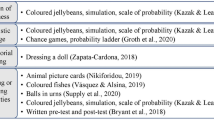Abstract
The National Council of Teachers of Mathematics (NCTM) states that “Communication is an essential part of mathematics and mathematics education” (2000, p. 60). In fact, communication is one of the five process standards emphasized by NCTM. The communication standard highlights the importance of young children communicating their mathematical thinking coherently to peers and teachers. This standard also states that young children should use math language to express mathematical ideas (Baroody, 2000; Ginsburg, Inoue, & Seo, 1999; NCTM, 2000; Rubenstein & Thompson, 2002; Whitin & Whitin, 2003). Teachers must create a link between mathematics and language (Rubenstein & Thompson, 2002; Stigler & Hiebert, 2004). This article focuses on the informal strategies used by Melissa (a kindergarten teacher) that promoted the use of math language. The strategies were identified during a 3-month observational period in her classroom at Clinton Elementary (pseudonym). Clinton Elementary is located in a low-income neighborhood of a southern city that has a population of approximately 450,000. The neighborhood population is predominantly African-American (Davis, 1994).
Similar content being viewed by others
REFERENCES
Baroody A. J., (2000). Does mathematics instruction for three-to five-year-olds really make sense? Young Children 55(4): 61–67
Baroody A. J., Wilkins J. L. (1999). The development of informal counting, number and arithmetic skills and concepts. In: Copley J. V., (eds) Mathematics in the early years NCTM, Reston VA, pp. 48--65
Davis B., (1994). An ethnographic study of a kindergarten teacher’s beliefs and practices before and after mathematics in-service Unpublished doctoral dissertation. Louisiana State University, Baton Rouge
Gallenstein N. L., (2003). Creative construction of mathematics and science concepts in early childhood. In Copley J. V., (eds) Mathematics in the early years NCTM, Reston, VA, pp. 88–99
Ginsburg H. P., Inoue N. & Seo K.-H. (1999). Young children doing mathematics: Observations of everyday activities. In: Copley J. V., (Ed.) Mathematics in the early years NCTM, Reston, VA, pp. 88–99
National Council of Teachers of Mathematics. (1989). Curriculum and evaluation standards for school mathematics. NCTM, Reston, VA
National Council of Teachers of Mathematics. (2000). Principles and standards for school mathematics NCTM, Reston, VA
Rubenstein R. N., & Thompson D. R. (2002). Understanding and supporting children’s mathematical vocabulary development. Teaching Children Mathematics, 9(2), 107–112
Schmidt W. H., (2004). A vision for mathematics Educational leadership 61(5): 6–11
Smith S. S. (1999). Early childhood mathematics. In Dialogue on early childhood science, mathematics and technology (pp. 84–91). Washington, DC: The Association of Administrators in Academic Pediatrics
Smith S. S. (2001). Early childhood mathematics (2). Allyn and Bacon. Boston
Stigler J. W., Hiebert J. (2004). Improving mathematics teaching Educational Leadership 61(4): 12–17
Whitin P., Whitin D. J., (2003). Developing mathematical understanding along the yellow brick road Young Children 58(1): 36–40
Author information
Authors and Affiliations
Corresponding author
Rights and permissions
About this article
Cite this article
Cooke, B.D., Buchholz, D. Mathematical Communication in the Classroom: A Teacher Makes a Difference. Early Childhood Educ J 32, 365–369 (2005). https://doi.org/10.1007/s10643-005-0007-5
Published:
Issue Date:
DOI: https://doi.org/10.1007/s10643-005-0007-5




